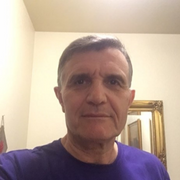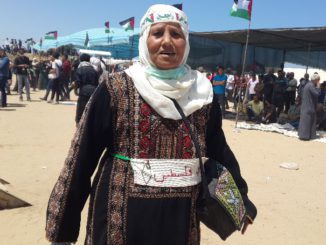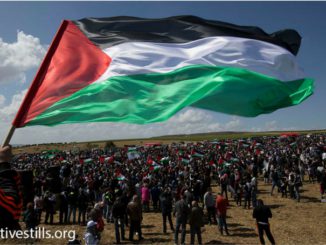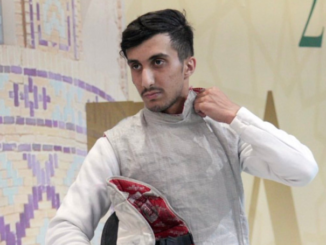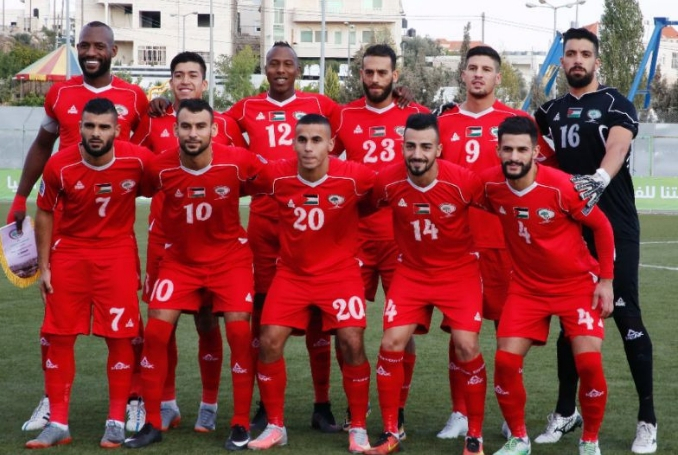
Most of sport sociologists believe that nothing awakens national feeling so easily and strongly as sporting success. Glorious history, royalty, a splendid army, democracy and the welfare system, ancient ideals and traditions – none of these things can measure up to sport in providing bonds of national solidarity or in creating a collective consciousness of one’s country.
“It’s [sport] a power that can move people’s feelings in a way that nothing else can do,” said South African leader Nelson Mandela after his country won the Rugby World Championships in 1995. During the last World Cup in Moscow many commented on social media wishing to see Palestine participating in the World Cup; to hear the Palestinian national anthem. Let’s imagine what it would feel like if that happened? Even when we heard the national anthem of other countries, we had a great desire to hear our own national anthem!
Palestinians always sought through sports a sense of national identity, independence and world recognition. At the time when the world did not recognize the Palestinian people after the Nakba (or catastrophe of 1948) sport was one of the most important means to prove their existence and to maintain their identity.
When a team like Al-Wihdat Club (in Al-Wahdat camp in Jordan), the late Yasser Arafat said:
“When we did not have a voice, Al-Wihdat was our voice.”
Throughout decades sport was a mirror that reflected Palestinian reality; it portrayed this reality with all its details throughout different historical stages. Sports development has often been parallel to and overlapping with political developments.
The Palestinian struggle has always been multilateral and sport was one of them. Therefore, it is difficult to understand many aspects of the modern Palestinian society without realizing the status of the sport, which has become a distinguished culture within the Palestinian culture.
The realization of many aspects of the history of Palestine requires examining Palestinian sports process for almost 100 years. Unfortunately, this was not perceived by many Palestinian historians and intellectuals who were and still looking at the sport as an abstract entertaining activity with no vain, ignoring its national, social, educational, moral, health aspects.
The true beginning of the phenomenon of establishing social-athletic clubs in Palestine can be traced to the early twentieth century, specifically the 1920s. Since that time, sports – especially football – had become a social tradition; a pivotal part of Palestinian culture. Many of these clubs were established as social-cultural clubs.
Only a few clubs were established solely as athletic, while the majority emerged as social and later adopted athletic activities. By 1948, there were some 65 athletic clubs in Palestine; approximately 55 of them were members of the Arab Palestine Sports Federation (APSF) which was established in 1931 and re-established in 1944. These clubs had a tremendous impact on the lives of Palestinian young people, shaping their character and preparing them for social and political involvement.
Sport was able to bring together youth from cities and villages. In addition, in the first half of the twentieth century sport was a catalyst in founding of many clubs that started as a football teams and then developed into athletic clubs where football (besides boxing, wrestling and weightlifting) was one the main activities that clubs practiced in addition to cultural, artistic, social and national.
The Nakba was almost a fatal blow for the Palestinian sports. The sports infrastructure was destroyed including Palestine Sports Federation PSF, schools, scouts, playing grounds, sports media, etc. Most of the clubs’ documents and books were confiscated, many club buildings fell under the Absentee Property Law.
This law is one of the most striking, as it declares that those who left the country during the fighting of 1948 no longer have rights to their property if they departed for an “enemy country,” and that those internally displaced are considered “present absentees;” still without access to their land and property.
In the Shatat (Diaspora), Palestinians carried with them their athletic experience and skills. They practiced football in the narrow alleys of the refugee camps. Despite their sufferings, they found in sports a breather in the refugee camps. It became a subject of childhood and homeland memories; a means for self-assertion and existence; a good medium for the recognition of Palestinian rights, and a way for maintaining national identity.
Palestinian sports had the capacity to recover from difficulties, this resilience was due to the previous experience and the severity of the dispersion and dispossession.
Despite the conditions in which Palestinians were living after the Nakba, many social-athletic clubs were established. Most of them were in the refugee camps. Many were named after the cities and villages which were abandoned during the Nakba, or after the areas that had been settled. Establishing new social-athletic clubs helped to promote sports growth.
Under the Egyptian administration, Gaza Strip made remarkable progress in sports, especially football. In 1962, the Palestine Football Federation was founded and immediately applied for the membership in the International Football Association FIFA.
However, its request was rejected under the pretext that the Gaza was a “territory under the control” of Egypt (then the United Arab Republic) and for which the UAR is internationally responsible. FIFA claimed that acceptance of part of a state as an independent member is in contradiction to FIFA rules.
At the same time, other federations were founded such as table tennis, track, field and basketball and boxing. The first three were admitted to their respective international federations while boxing had been rejected for the same reasons that Palestine was a “territory under the control” of Egypt.
During that time, Palestine participated in the first Pan Arab Games in Alexandria in 1953, where it won third place. The majority of the players on the team were from Gaza Sector. In 1965 a football team from Gaza and Diaspora (Syria, Egypt, and Lebanon). It also participated in the second, third and fourth Pan Arab Games. This participation has raised the name of Palestine high and proved that sports at that period played a pivotal role in maintaining and demonstrating Palestinian national identity.
After 1967, Palestine’s sports’ center of gravity of was moved from Gaza to Jordan and then to Lebanon where the Palestine Football Federation was established in 1971. With the support of the Palestine Liberation Organization, Palestinian sport was able to enter the Arab and international arena.
Palestine’s football national team had many friendly and official matches in Lebanon and Arab countries. This selected team included Palestinian players from Lebanon, Iraq, Syria, Jordan, Kuwait, and Egypt. However, the majority of players were from Lebanon. Because of the Israeli restrictions the team did not include any player from Gaza Sector or West Bank.
Other federations were founded such as handball, boxing, gymnastics, swimming and weightlifting. Later they became members of their respective Arab, Asian and international federations.
The post-1967 period in the West Bank and Sector Gaza was characterized by a lack of governmental institutions, such as a department or ministry of youth and sport, sports associations (federations). These institutions are the basic factor behind the growth of sports in any country. However, this did not prevent the development of sports. The absence of a state may have its positive effects on many aspects.
The lack of central authority led to the development of a vibrant civil society. The ‘Association of Athletic Clubs’ Rabitat al-Andiyyah al-Riyadiyya was established in 1975. In 1978 the ‘Association of Clubs’ Rabitat al-Andiya was established in Gaza Sector.
The first official match between the teams in the West Bank and Gaza was in the early seventies on al-Yarmouk Stadium in Gaza. The match was between a selected team from Jerusalem and a selected team from Gaza, which ended with a tie. Al-Rabita (in both Gaza and West Bank) functioned as a federation for different sports (football, basketball, volleyball and table tennis). It brought all the clubs together and sustained the links between the West Bank and Gaza Sector.
It is worth mentioning that al-Rabita took its legitimacy from the wide fundament of the people and athletes in the West Bank and Gaza Sector. Many football (and other sports) matches ended with demonstrations against the occupation; they were interrupted with chants and songs demanding the end of the Israeli occupation. These matches represented a national celebration among the Palestinian people.
After the initial breakout of the Intifada, al-Rabita was suspended spontaneously until the end of 1991 and re-established in January 1992. It brought back all the athletic committees that were registered members of al-Rabita before the Intifada. However, it was suspended again due to the Oslo Agreement and the construction of the new institutions by the Palestinian Authority which competed with the existing Palestinian civil organization and sought to control or suspend them.
The admission of Palestine in the International Football Association FIFA in 1998 was a turning point in Palestinian football. This affiliation which came after four attempts, could be a historic step toward the statehood, it refuted the Israeli claims; such claims alleged that the Palestinians lack the ingredients to be represented in international organizations and associations.
It became obvious, that the affiliation with the international organizations (such as FIFA, IOC in 1995 and others) plowed the way for Palestine to become a non-member observer state in the United Nations in November 2012.
In fact, this membership helped to improve PFA’s performance in many aspects; it accelerated the growth and progress of football in Palestine and gave the Palestinian national team a chance to participate in the international arena. FIFA supported Palestinian football financially and logistically. It built the first stadium according to FIFA standards and helped raise donations from several countries for this purpose.
Believing that Palestinians deserve to live and practice a normal daily life, in one on his visits to Palestine FIFA’s former president Sepp Blatter said that “Youngsters across the region need to have the opportunity to play football. It can build bridges, bring young people in the region together, and give them hope.”
However, as Daoud Kuttab pointed out that it is clear that the politics of FIFA are moving away from the kind of support that former FIFA president had displayed toward Palestinians.
After becoming a FIFA member in 1998, Palestine won the bronze medal at the 9th Arab Games in Amman in 1999. It has not yet qualified for the World Cup, but it qualified for the first time for the Asian Cup in May 2014. Today, Palestine stands in the ranking of FIFA in the ninety-ninth place. In it was able to reach the rank of seventy-third, and to outperform many of the teams from other countries.
In 2008 began the first league for the season 2008 – 2009 with the participation of twenty-two clubs in the West Bank. The Palestinian Football Federation has adhered to FIFA rules and regulations of professional. The Premier League started in 2010-2011 in the West Bank with the participation of 12 teams.
In 1995, the Palestinian Olympic Committee joined the International Olympic committee, it was a result of the ongoing efforts which have been waged on the international arena since the 1970s throughout 1990s. These efforts went parallel with Palestine’s efforts to join the FIFA.
Palestine’s’ first participation in the Olympics was in Atlanta in 1996. Maher Abu Rmeileh a 28 years old Judoka was the first athlete reached the qualifying standards. Abu Rmeileh carried the hope of his people and the Palestinian flag at the opening ceremony in London 2012.
In an interview, he said:
“I am proud to fly high the Palestinian flag during the ceremony; this is an affirmation that we Palestinians exist and hope our state will be one day as other sovereign states around the world.”
The relative underperformance of Arab nations in the Olympics can be explained by a number of variables such as finance, demography, sporting culture, policy and governance. In Palestine beside political conditions that resulted from the Israeli occupation, there were a number of obstacles stood in from Palestinian athletes who participated in the Olympics. Among them was the lack of financial and moral support and the shortage of facilities.
In 2002, the Palestinian women’s team was formed. This was a bold step to challenge the customs and traditions of society, to create new opportunities for Palestinian girls, to achieve gender equality, and send a message to the community that girls can do what men do. Women’s football activities and their participation at the local, Arab and international levels have led to a change the stereotype that prevailed in the society. This was a victory for women despite other obstacles that they still face.
Of course there are obstacles and challenges in front of Palestinian sports, the most important of which is the Israeli occupation, which puts obstacles to the sport in general through the arrest of players and strangling movement, and not to allow them to travel, and bombing stadiums and terraces as happened during the aggression on Gaza in 2008 and 2014, the confiscation of land, the building of settlements and the daily harassment of settlers by citizens.
It is no stranger to the reader that the Israeli Football Association has allowed five clubs set up on the land of illegal settlements in the West Bank, playing and participating in the Israeli league championship, as well as participating in all the various official competitions, which violates the laws and charters of the International Federation and the United Nations These territories are under occupation and the occupying authorities cannot exercise any official activity on them.
FIFA has refused to take any punitive measures against Israeli settlement clubs playing in the West Bank and participating in the Israeli league, FIFA confirmed at its meeting in Kolkata, India, in October 2017 when it declared it should remain neutral. In spite of the pressure by the Palestine Football Federation on the grounds that the FIFA law prevents clubs from member states from playing in the territory of another union without his consent.
Despite dispersion and exile, Palestinian sports, prior to the Oslo Agreement enjoyed more democracy and integration than today. What is happening today is that some parts of Palestinian Diaspora (especially in Lebanon) feels neglected and marginalized.
Palestine Football Association’s (based in Ramallah) focus was and still on the West Bank. The second Football Association has been established in Lebanon (Palestine Football Association in Diaspora – Lebanon Branch). Obviously, a lack of coordination between these two associations is existing.
When comparing between the situations in Gaza and the West Bank before and after the Oslo Agreement, one will easily notice the increasing gap between the two as a result of the obstacle that the occupation put in place. Due to the settlement, checkpoints, and the separation wall the West Bank was torn. This had led to the dispersion of the Palestinian sports. Isolating Jerusalem was another big problem.
The Fatah-Hamas division has negative repercussions on Palestinian sports, it is causing paralysis of the Palestinian sports movement. Many players and managers hope that negotiations between the two sides will help reach the lofty goal of Palestinian unity. Unfortunately, this success that Palestine achieved internally, regionally and internationally has been held back by the Fatah-Hamas division.
Today, one of the main obstacles in front of the current sports movement is in its lack of democracy and subjection to partisanship. This division in sports came to help Israel who was dreaming to ‘divide and conquer’ the Palestinian national arena.
– Issam Khalidi is an independent scholar living in Monterey, California, is the author of History of Sports in Palestine 1900-1948 (in Arabic), One Hundred Years of Football in Palestine (in Arabic and English), co-edited Soccer in the Middle East (Rutledge.), as well as articles and essays on the subject of sports included at www.hpalestinesports.net
